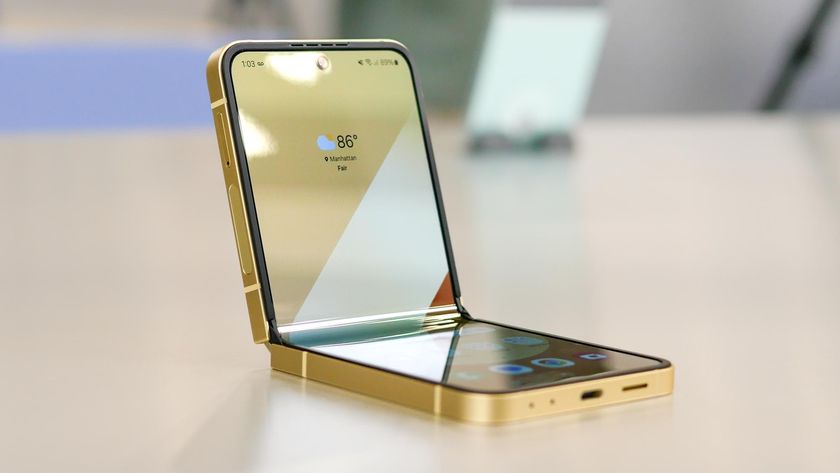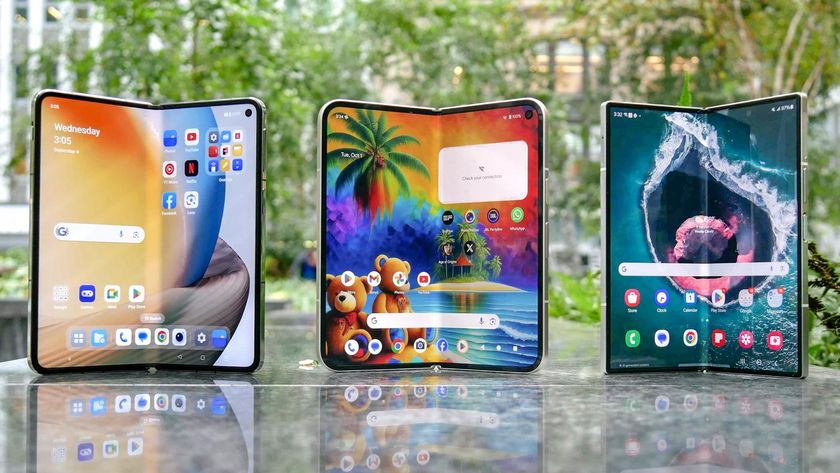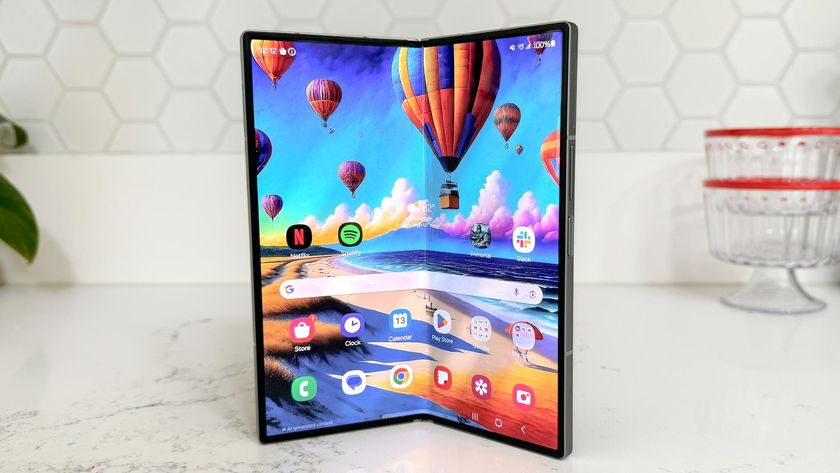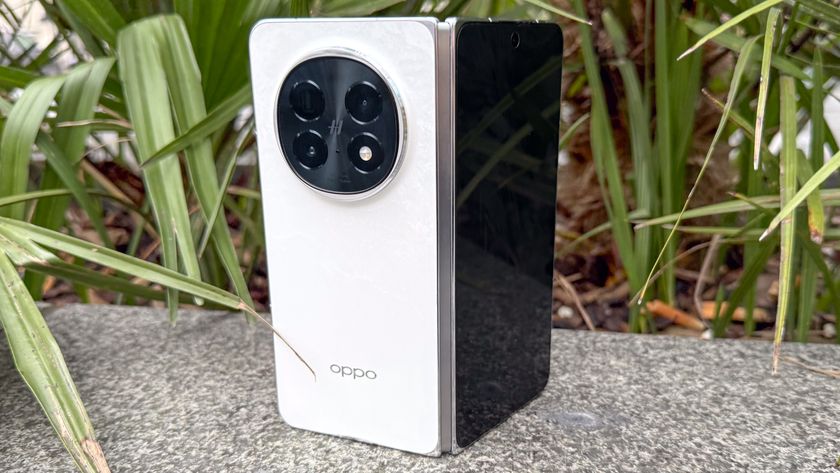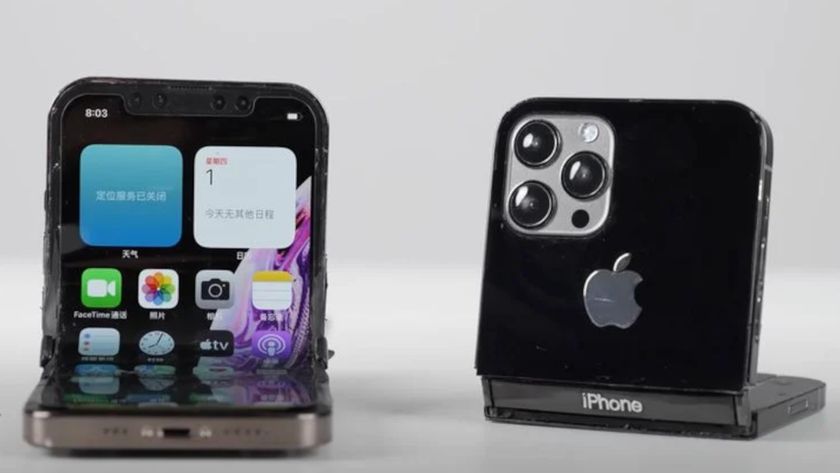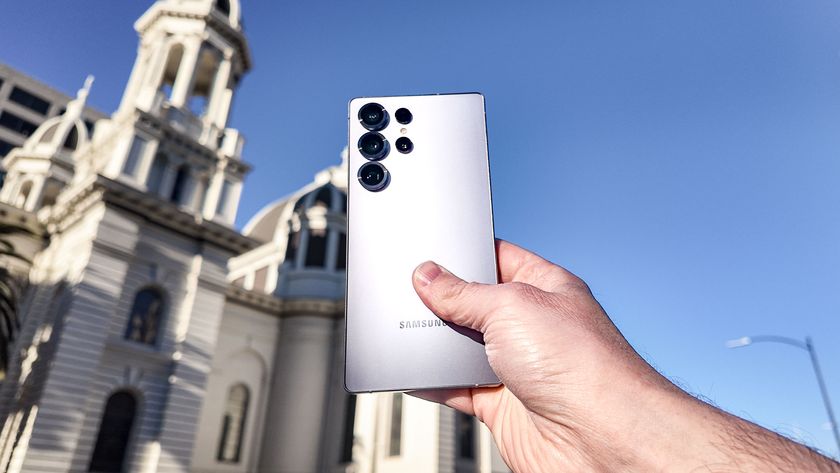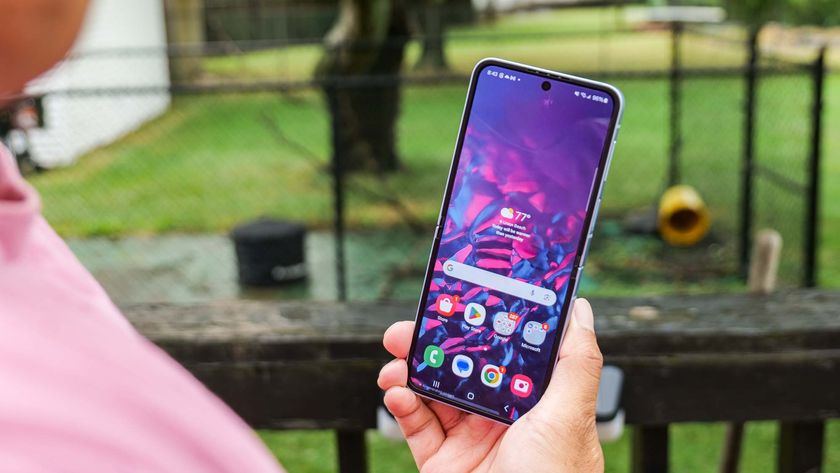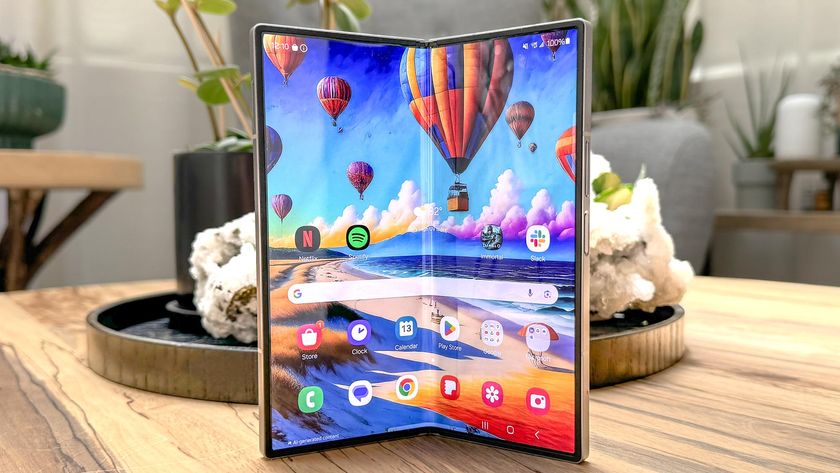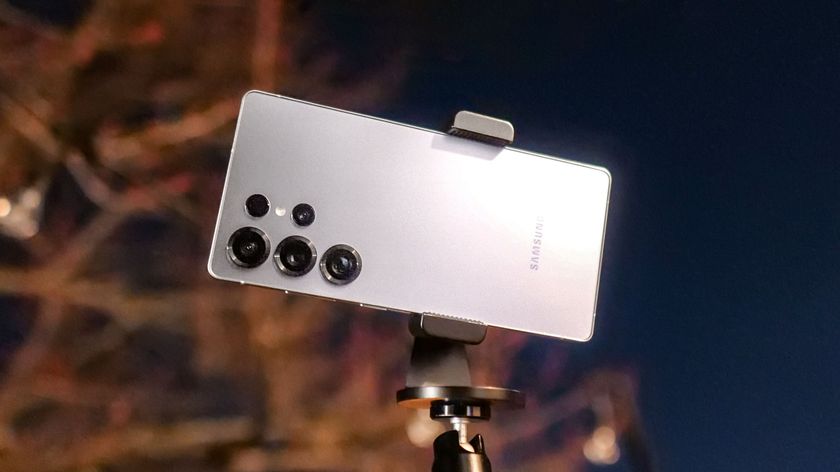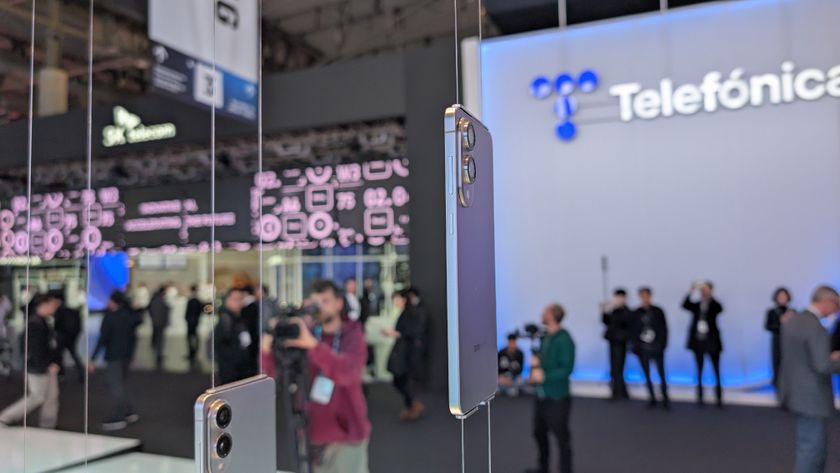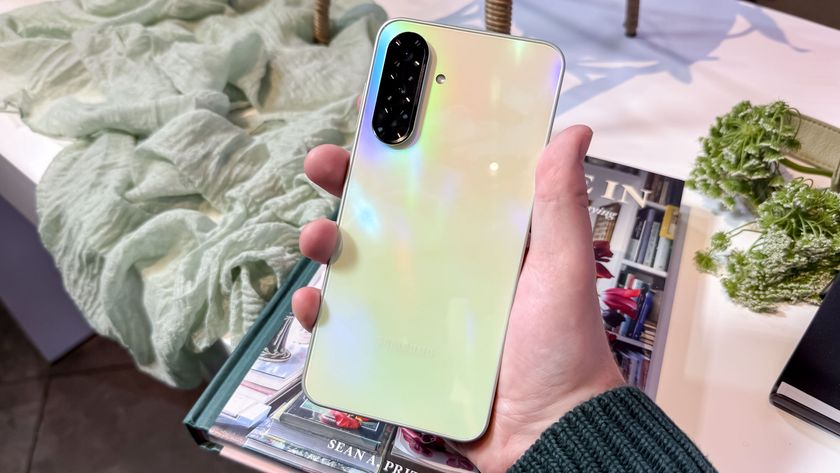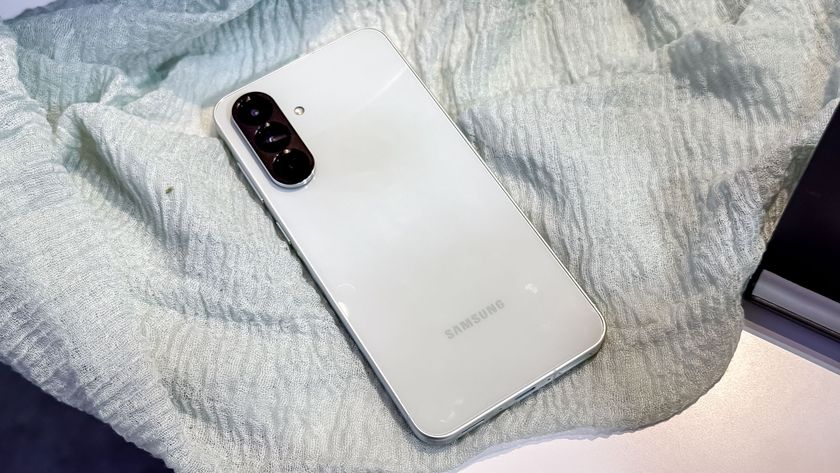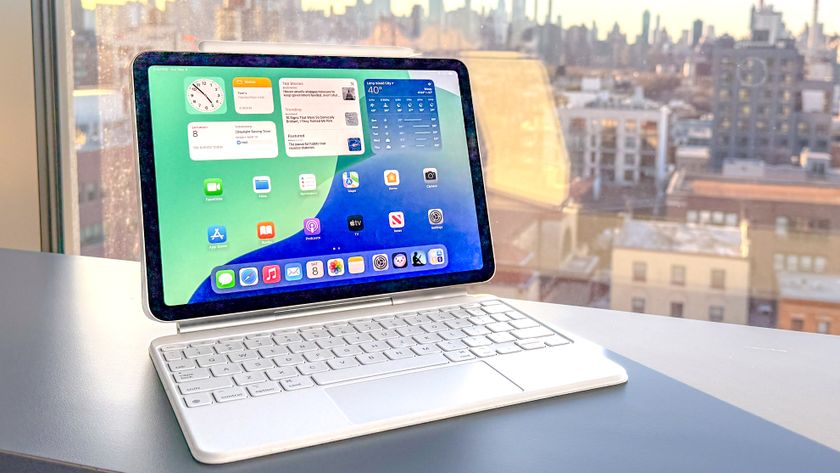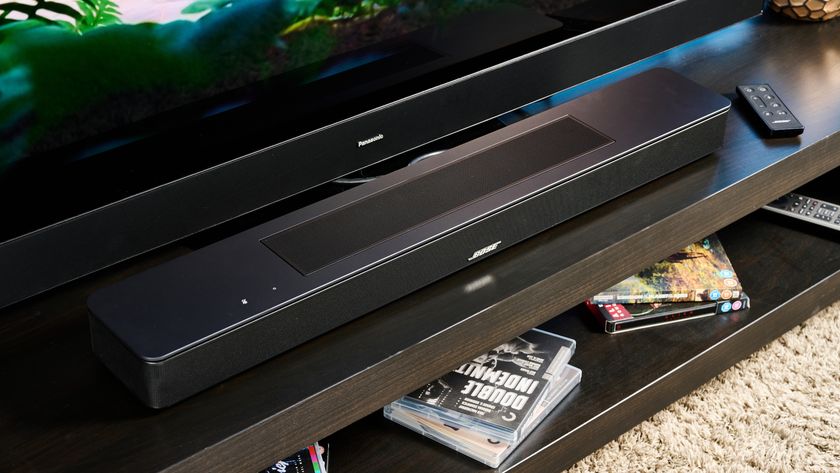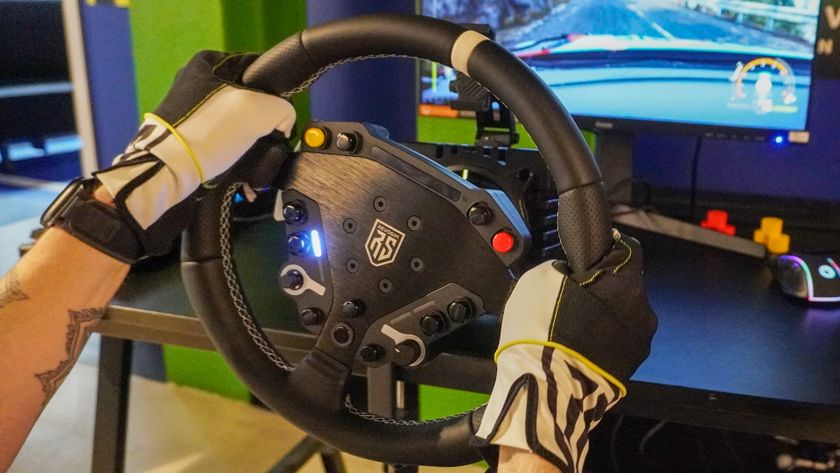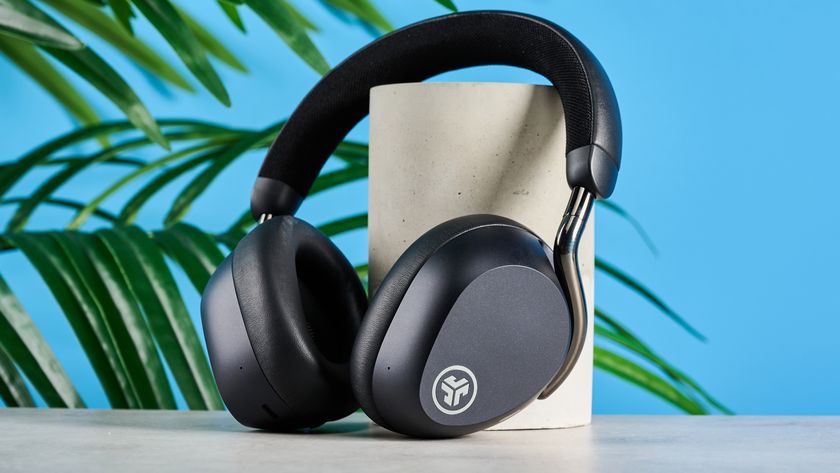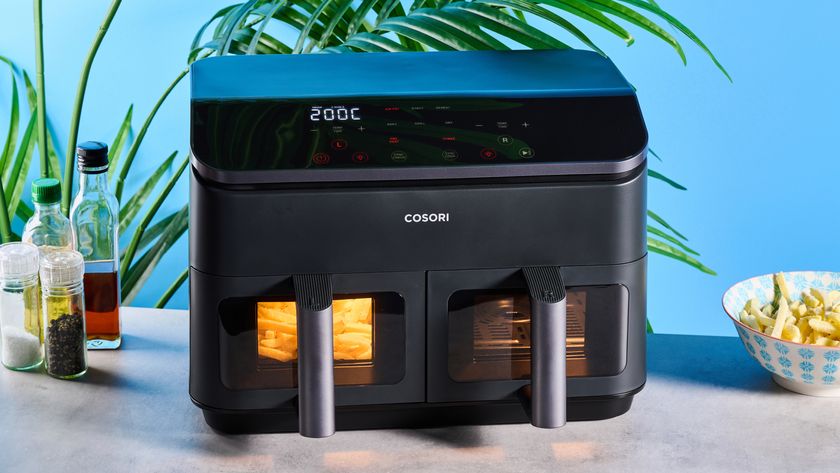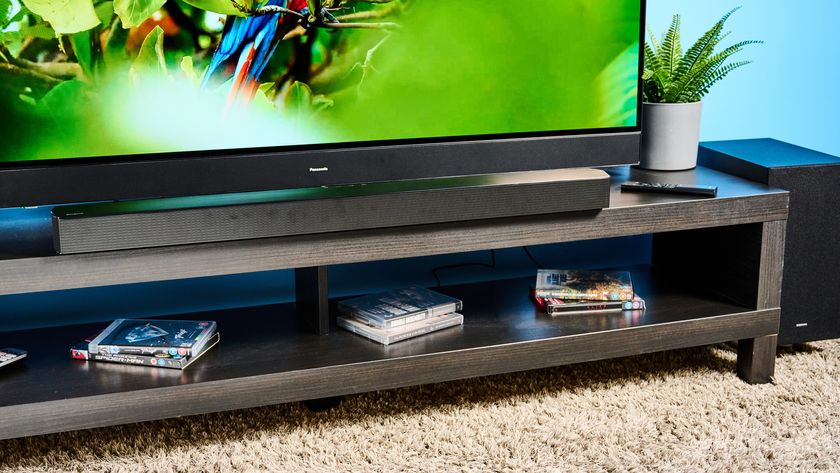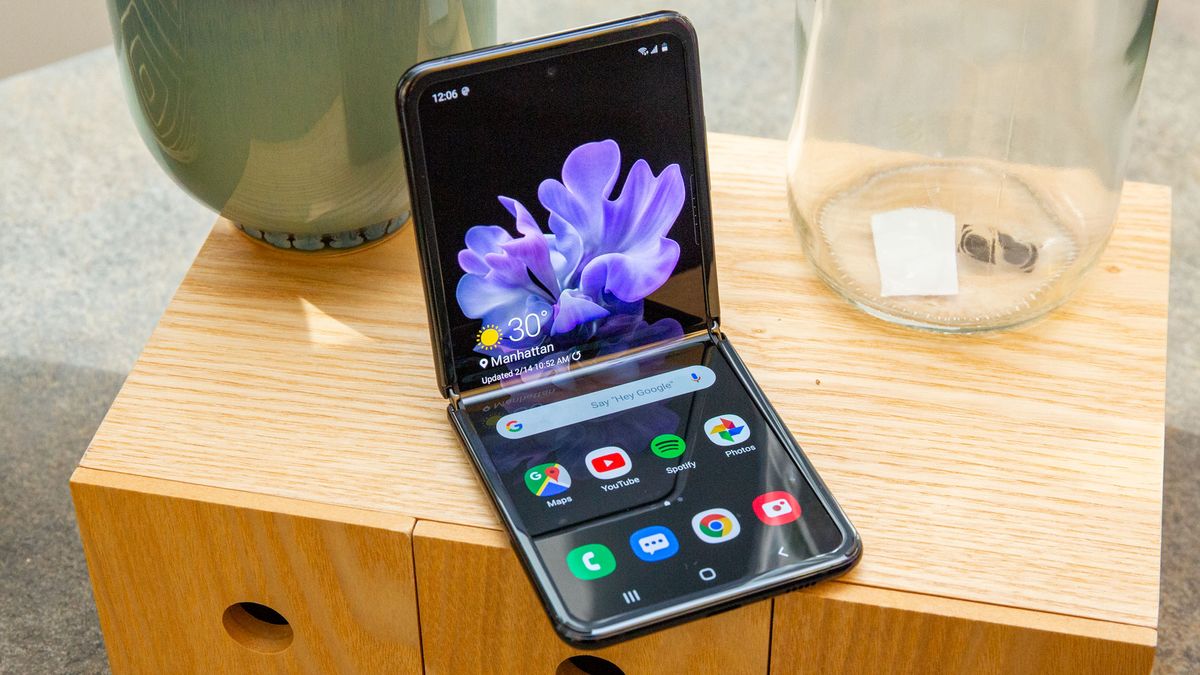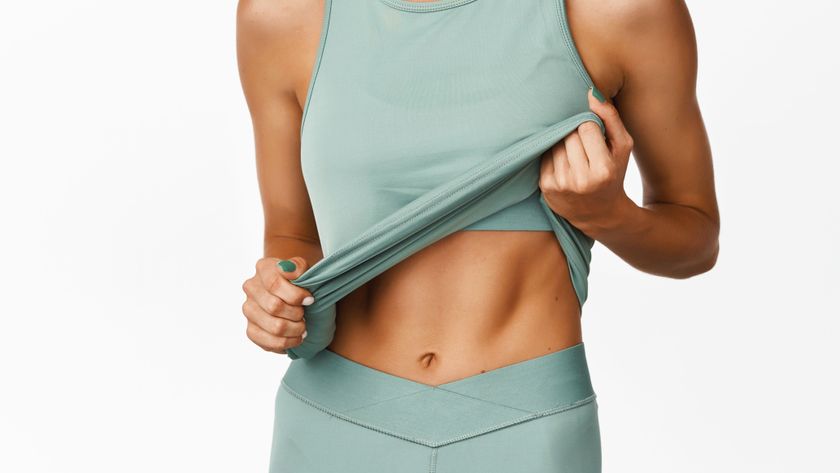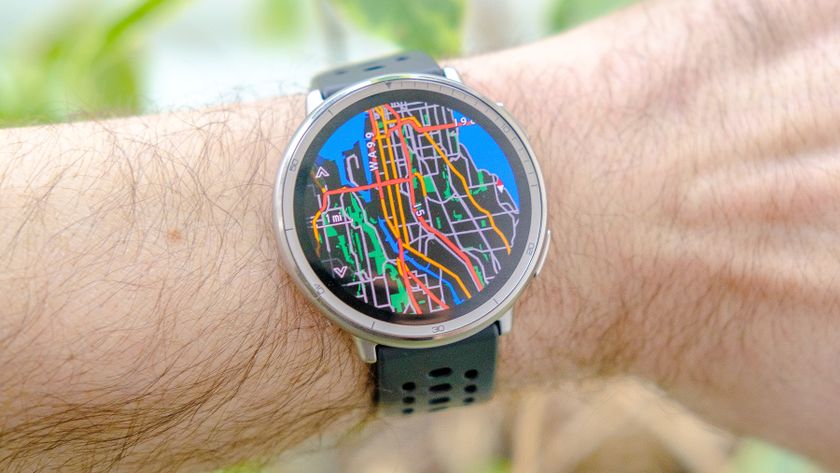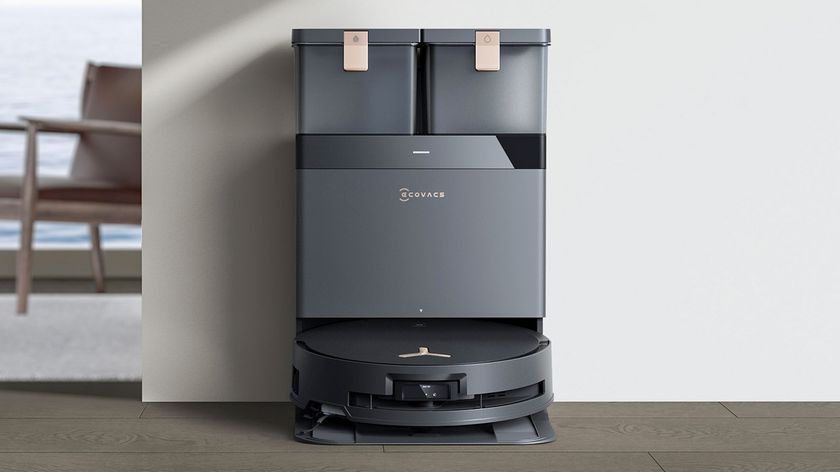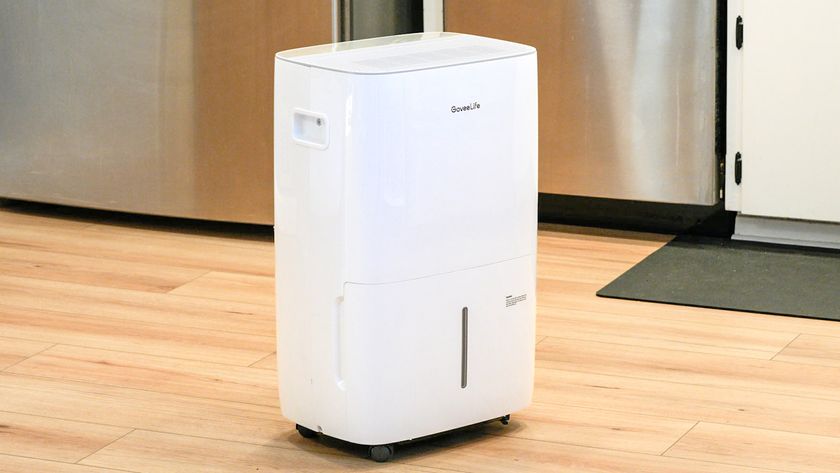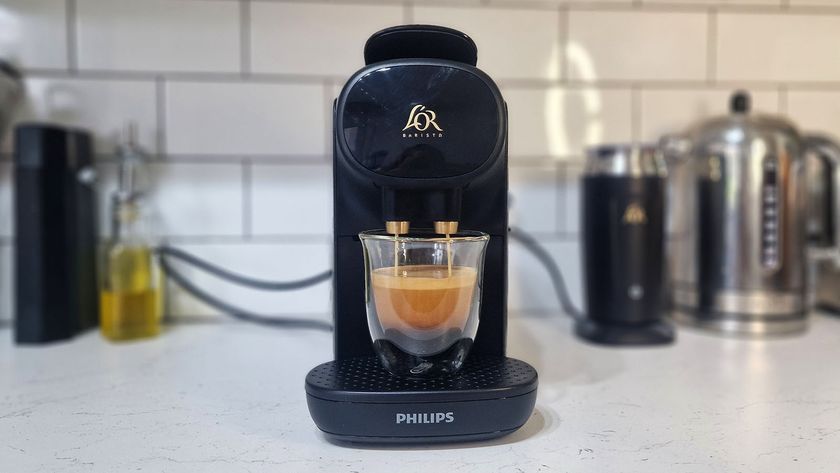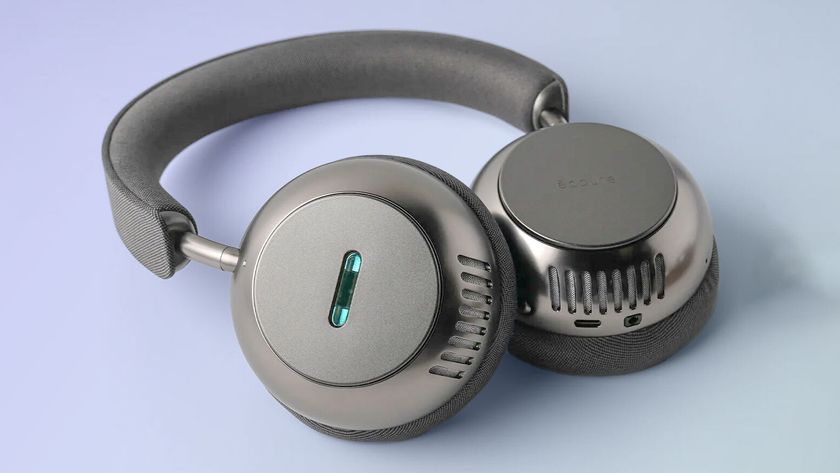Tom's Guide Verdict
The Galaxy Z Flip was the best foldable phone, at least until the Galaxy Z Fold 2 came along. As clever as the design of the Flip is, at a still-high $1,380, it’s hard to recommend this phone over more traditional flagships like the iPhone 11 Pro and Galaxy S20 Plus.
Pros
- +
Snapdragon 855 Plus is plenty powerful
- +
Ultra-thin glass aids durability
- +
Compact design when folded
- +
Less expensive than other foldables
Cons
- -
Subpar battery life
- -
Exterior smudges easily
- -
Still pretty pricey at $1,380
Why you can trust Tom's Guide
The Samsung Galaxy Z Flip has pulled off a feat that eluded the Galaxy Fold, Samsung’s original foldable device: The Z Flip can fit in your pocket when it’s closed.
Price: $1,299 (LTE), $1,199 (5G)
Screen (open): 6.7-inch Super AMOLED (2636 x 1080)
Exterior screen: 1.1-inch Super AMOLED (300 x 112)
CPU: Snapdragon 855 Plus
RAM: 8GB
Storage: 256GB
Cameras: 2 12MP (main: f/1.8; ultra wide: f/2.2) rear/10MP (f/2.0) front
Battery: 3,300 mAh
Size (open): 6.6 x 2.9 x 0.28 inches
Size (folded): 3.4 x 2.9 x 0.61-0.68 inches
Weight: 6.5 ounces
That wasn't the case with the original Fold, a device that opened up horizontally like a book to unveil a 7.3-inch display. The Galaxy Z Flip is different. This time around, Samsung uses a flip-phone design. (Yes, exactly like the Motorola Razr.) The Z Flip flips open vertically to reveal a 6.7-inch display that includes a layer of ultra-thin glass for an extra level of polish. More importantly, when the phone is shut, it's tiny — a closed-up Z Flip fits easily in my hand and my paws aren't exactly meaty.
That’s a promising start for the Galaxy Z Flip, but is it enough to make this the foldable phone to beat? And more importantly, has Samsung done enough to justify the Z Flip’s four-figure asking price? Our Samsung Galaxy Z Flip review gets to the bottom of those key questions.
- Best foldable phones: Where the Galaxy Z Flip ranks
- Microsoft Surface Duo vs. Samsung Galaxy Z Flip 2: Battle of the foldables
Samsung Galaxy Z Flip review: Price and availability
Before you even examine the relative merits of the Samsung Galaxy Z Flip, one of its most appealing attributes may be its price. Debuting at $1,380 last year, the Galaxy Z Flip isn’t cheap by any stretch of the imagination. But in the world of pricey foldable devices, Samsung’s flip phone feels like a bargain.
The Galaxy Z Flip’s $1,380 price was a $600 drop from the debut price of the Samsung Galaxy Fold. The Galaxy Z Flip also costs less than the $1,500 the Motorola Razr. And the price has fallen even further in the subsequent months, as you can now pick up a Galaxy Z Flip for $1,299.
You can get the Galaxy Z Flip from AT&T, Best Buy and Samsung. However, these days, the focus is on the Galaxy Z Flip 5G, an updated version of the phone that came out after we published our Galaxy Z Flip review. The Galaxy Z Flip 5G features a more powerful Snapdragon 865 Plus processor with a 5G modem, and it makes some improvements to the multitasking features. Originally, $1,499, the Galaxy Z Flip 5G now now costs $1,199, which is the same price as the Galaxy S21 Ultra.
We're focusing on the Galaxy Z Flip for this review, but everything with the exception of performance would be the same with the Galaxy Z Flip 5G.
Samsung Galaxy Z Flip review: Design
The distinctive thing about the Samsung Galaxy Z Flip's design is its horizontal hinge, a contrast to the vertical hinge that the Galaxy Fold used. Samsung claims it can flip open 200,000 times.
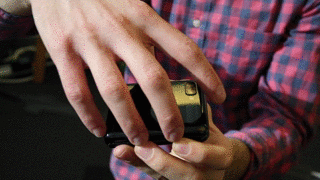
We haven’t put the hinge to that much use in our time with the Z Flip, but it does feel pretty durable. (According to the YouTube channel JerryRigsEverything, the Galaxy Z Flip’s display behaves more like plastic than glass when subject to various torture tests.) We’ve dropped the phone on a hardwood floor without damaging the hinge, outer case or display.
More significantly, the Z Flip's hideaway hinge is designed to keep out dust. It's got a thin layer of fabric to make sure particles can't find their way into the gap that exists between screen and hinge. Dust is what felled the original version of the Galaxy Fold, forcing Samsung to delay that phone's release. This suggests that Samsung has learned its lessons.

When open, the Galaxy Z Flip's screen measures 6.7 inches from corner to corner. Rather than using plastic to protect the panel — the tack taken by every foldable maker prior to the Z Flip — Samsung has turned to a new ultra-thin glass material that seems to make the display less prone to damage. The most definitive thing we can say in that regard is "so far, so good," but at least the Galaxy Z Flip feels more polished than other foldable phones.
Speaking of polish, you'll need to apply a lot to the exterior metal case of the Galaxy Z Flip. On our Mirror Purple edition of the phone, our fingerprints are very visible on the reflective glass exterior. That's a shame, because it mars an otherwise stylish look that you'd be eager to show off, as the Mirror Purple is especially eye-catching.
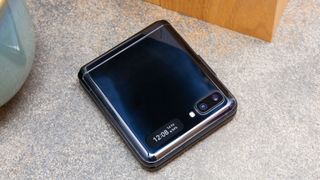
You can also opt for Mirror Black and — in some countries — Mirror Gold. When we first laid eyes on the Galaxy Z Flip, we thought Mirror Gold was the sharpest of its looks, but the light lavender glow of Mirror Purple has grown on us.
Samsung Galaxy Z Flip review: Display
Samsung has turned to a full-HD+ display for the Galaxy Z Flip, with a resolution of 2636 x 1080 pixels. That's a lower resolution than the quad-HD+ panels inside the Galaxy S20 series, but it's certainly sharper than the Razr's 6.2-inch, HD+ screen.
If you had hoped that Samsung would figure out a way to get rid of the crease that marred the Galaxy Fold experience, you're going to be disappointed. There is indeed a crease where the top and bottom halves of the Z Flip's extended screen meet, and it's not that difficult to spot when the screen’s not in use.
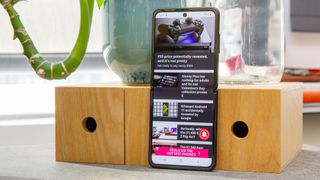
Still, when we were watching a video on Netflix or playing PUBG Mobile, the crease was lost in the inky black of the Galaxy Z Flip’s AMOLED panel. While you wish that a $1,380 phone wouldn’t have any visible crease, at least the Z Flip’s modest bend isn’t as noticeable as the Razr's gigantic crease.
Samsung has managed to fit a pretty colorful display into the Galaxy Z Flip’s folding frame. In its default Vivid setting, the screen captured 200.8% of the sRGB color spectrum, which means bright, if saturated, colors. For context, the Galaxy S20 Plus captured 224.4% of the sRGB color spectrum.
Switch the viewing mode to Natural, and you’ll see 122.1% of the sRGB color spectrum on the Galaxy Z Flip, comparable to what we registered when testing the Galaxy Fold’s Natural mode (124.8%.).
Those colors could be more accurate. The Samsung Galaxy Z Flip has a Delta-E rating of 0.31 in Vivid mode compared to the S20 Plus’ 0.36 rating — numbers closer to zero are better — but Apple’s iPhone 11 Pro Max tops both, with a Delta-E rating of 0.28. You’ll get more accurate colors when switching over to Natural mode on the Z Flip, where the color accuracy rating improves to 0.21.
In real-world use, you’ll enjoy watching video on the Galaxy Z Flip’s screen, even if the 21.9:9 aspect ratio is probably more narrow than you’re used to on a mobile device. (For context, the 6.7-inch Galaxy S20 Plus offers a 20.9:9 aspect ratio, and the difference is noticeable.)
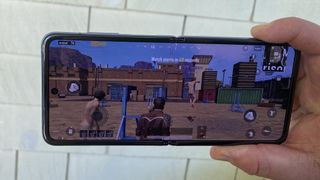
On other phones, some scenes of the No Time to Die trailer on YouTube can seem overly dark, but you can still make out James Bond’s facial features even in the shadows. The phone also did justice to the colorful costumes in Dolemite Is My Name on Netflix.
Shining a flashlight at the Galaxy Z Flip screen, we recorded 677 nits of brightness with a light meter. That’s not as bright as the Galaxy S20 Plus (847 nits) or iPhone 11 Pro Max (761 nits), but it’s a big improvement over the 552 nits we recorded when testing the Galaxy Fold. Still, when using the Galaxy Z Flip in broad daylight, we had to squint to see the camera controls until we maxed out the display brightness.
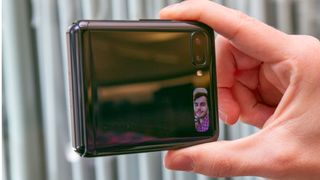
That internal display is not the only screen on the Galaxy Z Flip. On the phone's exterior, you'll find a 1.1-inch Super AMOLED panel that's just big enough to notify you of incoming calls, texts and alarms. It can also display the date and time, so you're not flipping open the phone just to see what time it is.
We had doubts about the utility of this screen, and we don’t like that Samsung placed it just to the left of the phone's dual exterior cameras. But the exterior panel serves several functions: You can use it as a mini-view finder to shoot selfies with the Z Flip closed. Just press the power button twice to summon up the viewfinder and then hit one of the volume buttons to snap the shot. You only see a sliver of your face, but it's still an ingenious way to save you from opening up the phone just for a self-portrait.
Samsung Galaxy Z Flip review: Using the device
Once you start using the Galaxy Z Flip, you’ll immediately notice how solidly built and sturdy it is. Compact though it may be, this is no flimsy phone. The outer case feels very substantial and opening the Z Flip takes some effort — we couldn’t pull it off one-handed, so we used one hand to steady the device and the other to lift its screen. Forget about whipping the Galaxy Z Flip out of your pocket and snapping it open with a flick of your wrist like the flip phones of old.
Then again, if you’ve used the foldable Motorola Razr, you wouldn’t see this as much of a problem. The build on Motorola’s new flip phone is one of its weakest points. The Razr proved difficult to flip open, it didn’t look like it would last long after too many accidental drops, and due to a design flaw, the flexible display actually lifts up from the chassis as you shut the device. None of these flaws are in evidence with the Galaxy Z Flip.
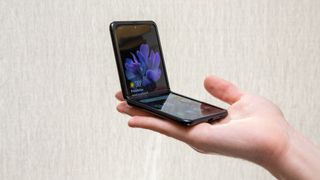
There's no sound when you open or close the Galaxy Z Flip — in contrast to the creaky noise the Motorola Razr makes. The nature of the free-stop hinge means you can stop adjusting the angle of the flexible display wherever you wish and the device will hold its orientation. That's extremely useful if you want to capture a selfie or video chat while going hands-free.
Samsung has dubbed this Flex mode, and when you enable it by opening the Z Flip into an L-shape, the top half of the Samsung Galaxy Z Flip's screen serves as a viewing area while all your actions are on the bottom of the screen. Use the camera app in Flex mode, for example, and the top of the screen becomes a viewfinder while the bottom houses the shutter button and menu options.
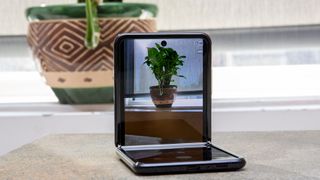
YouTube, which Google updated specifically for the Z Flip, displays the video in the upper portion of the screen, letting you scroll through comments and related content on the bottom. It’s a very clever use of the Z Flip’s unique design, but it would be even better if more apps took advantage of Flex mode.
One other thing we appreciated when using the Galaxy Z Flip was how flat the phone lays against surfaces when fully opened. That allows you to set down the Z Flip and tap away without experiencing any wobbles.
If that sounds like a small thing, consider that there’s always an angle at play with the Motorola Razr, even when fully opened. It's slight, but it's there and it's hard to ignore. It’s another flaw Samsung managed to avoid with its own foldable.
Samsung Galaxy Z Flip review: Camera
If you're a mobile-photography aficionado, you might be ever so slightly disappointed by the Samsung Galaxy Z Flip's primary camera module, which pairs two 12-megapixel sensors — one with an ƒ/1.8 regular wide lens, and the other with ƒ/2.2 ultra-wide optics.
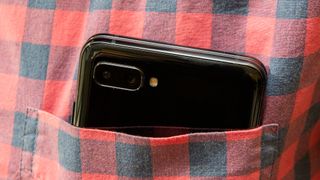
While that's half the number of lenses you'll get from the Galaxy S20 Plus and Galaxy S20 Ultra, the Samsung Galaxy Z Flip's cameras produced impressive results during our testing. Samsung's computational photography chops have been very close to Apple and Google's levels over the past several years, and the Z Flip should more than suffice in this department.
For example, the Samsung Galaxy Z Flip's ultra-wide camera squares up nicely with the 12-megapixel one inside the iPhone 11 Pro. Samsung's algorithms definitely brighten the darker regions more aggressively than Apple's, and there are some regions — like the brick walkway toward the bottom of the frame — that seem a tinge blown out. Otherwise, there's a lot to like here.
The Galaxy Z Flip does a decent job capturing this steak dinner, recreating the array of colors on the plate. But the same photo shot with an iPhone 11 Pro Max is warmer and presents a greater variety of textures on objects like the homemade potato chips and the lettuce leaves in the salad.
The Z Flip also captures a wider view even though I hadn’t switched to the phone’s ultra wide angle lens. The result is more of the surrounding area, but there’s also a noticeable bend to the Z Flip’s perspective.
The Night mode on the Galaxy Z Flip can hold its own against similar features on other devices, even if we’re not crazy about the fact that you have to dig into the More options on the Z Flip to enable it.
The iPhone 11 Pro Max takes night shots automatically and its rendition of a mural features the kind of well-balanced coloring we expect from Apple’s phones. It also didn’t struggle with light from a nearby street lamp that casts a glare on the Galaxy Z Flip’s shot.
Still, the Z Flip captures more detail around the mural, like the trees on the right side of the frame and the house on the left. These details sink into the shadows on the iPhone’s shot.
There’s little differentiating how the Galaxy Z Flip and iPhone 11 Pro Max handled this photo of a statue in a residential area. You could argue that Samsung’s phone produces the better image, given that the palm tree fronds have some color in its rendition. The iPhone’s version overly darkens the trees.
The real reason to take a photo of that statue, though, was to test out the ultra-wide-angle lens on the Galaxy Z Flip, and the result remains pleasing. You get a wider viewing angle in the Z Flip’s shot than what the iPhone 11 Pro Max produces, and the colors remain more vibrant in the Samsung photo. (One exception: the patches of blue sky are more alluring in the iPhone shot.)
If the Samsung phone falls down anywhere on wide-angle shots, it’s that the phone loses focus. Notice the fuzziness around the parked cars in the right background of the Z Flip’s photo. That’s not something you see in the iPhone 11 Pro Max shot, where everything remains sharp.
The Galaxy Z Flip doesn’t come with a telephoto lens, so to see if that’s a worthwhile sacrifice to make in a $1,380 phone, we relied on the camera’s digital zoom for a 2x look at the Oakland skyline. The shot’s not bad — the foreground is in sharp focus, the colors pop and the exposure’s fine.
But zero in on the details, and you’ll see how an optical zoom like the one on the Galaxy S20 Plus is more up to the task. The S20 keeps the Tribune Tower and the Wells Fargo sign next to it in focus; those are fuzzier in the Galaxy Z Flip’s rendition.
This portrait of my colleague Henry is also quite good, even if there are aspects we prefer from Apple's rendition. Henry's skin tone is a bit more natural through the iPhone's cameras, and of course the presence of a telephoto shooter on Apple's handset provides that more dramatic, zoomed-in look you probably want from a portrait. But the Z Flip appears to do a better job isolating Henry's clear glasses frames.
A 10MP front camera peeks out of you from a punch-hole cutout in the center of the Galaxy Z Flip’s interior display, just like the selfie cams on the S20 and Galaxy Note 10.
It does a decent job, but in this photo, shot in a challenging mixture of shadow and sunlight, the Z Flip produces muted colors and struggles with the shifts in lighting. Colors are more balanced in the photo captured by the iPhone 12 Pro Max’s 12MP selfie cam — not just the person in the photo, but the surrounding garden as well. And the iPhone isn’t as aggressive with skin smoothing as the Galaxy Z Flip.
One nice feature about the Galaxy Z Flip’s front camera is a Smart Selfie Angle component that automatically switches to a wide-angle shot when it detects more than two people are in the frame. The Galaxy Z Flip certainly detected the extra bodies in this shot and adjusted its focus accordingly — the feature probably works best for landscape selfies — though the issues with overexposure remain.
Samsung Galaxy Z Flip review: Performance
Samsung may have skipped the latest, greatest Android processor in the Galaxy Z Flip when it neglected to give it Qualcomm's then-brand new Snapdragon 865. However, at least the company is using the next best chip available.
That would be the Snapdragon 855 Plus, which debuted in 2019 in a small number of phones, including the OnePlus 7T. Because it's the 855 and not the 865, the Z Flip cannot connect to 5G networks — though it’s still very snappy, with 8GB of RAM. (If you want 5G, opt for the Galaxy Z Flip 5G and its more capable Snapdragon 865 Plus chipset.)
Additionally, a standard 256GB of storage provides plenty of space for apps, media and games. Forget about the microSD slot you’ll find on most Samsung flagships, though.
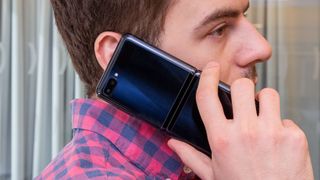
Samsung's latest foldable achieved a Geekbench 5 multi-core score of 2,689 points. The OnePlus 7T fared only slightly better than the Z Flip, notching a 2,759 score in Geekbench 5, while the Galaxy Fold and its slightly less powerful Snapdragon 855 chipset brought up the rear with a 2,619 tally.
In other words, expect the Galaxy Z Flip to turn in comparable performance to 2019’s Android flagships, even if phones with newer silicon leave it in the dust. The Galaxy S20 Plus, for example, rides its Snapdragon 865 chipset to a 3,076 score in Geekbench.
Graphics testing tells a similar story — the Galaxy Z Flip holds its own with devices that feature last year’s top-of-the-line Snapdragon system-on-chip while lagging behind newer flagship phones. On the GFXBench Aztec Ruins Vulkan test for high-tier phones, the Galaxy Z Flip’s score of 1,048 frames was in line with the 1,038 score produced by the Galaxy Fold. The Galaxy S20 Plus handily bested both foldable Samsung devices with a result of 1,319 frames.
This isn’t to say that the Galaxy Z Flip is a laggard. It kept up with any app I threw at it, even demanding games like PUBG Mobile. Android users who want the absolutely fastest phone available will want to turn elsewhere, but that’s hardly the appeal of the Galaxy Z Flip. And even if you do prize performance, the Z Flip is no slouch.
We haven't benchmarked the Galaxy Z Flip 5G yet, but we'd expect its performance to outshine the original Flip and to behave more like the Galaxy Z Fold 2, though that phone boasts more RAM.
Samsung Galaxy Z Flip review: Battery life and charging
Inside the Samsung Galaxy Z Flip is a 3,300-mAh battery, a respectable size for a foldable where there’s not a lot of room to spare. Consider that the Razr uses a tiny 2,510-mAh power pack and its battery life suffered as a consequence: Motorola’s phone lasted only 6 hours and 4 minutes on our demanding battery test, which involves continuous surfing over LTE until a fully charged phone runs out of power.
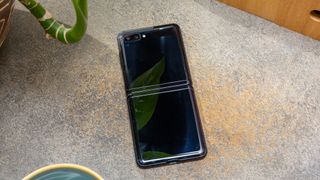
The Galaxy Z Flip fared better than that, though you won’t mistake this for a long-lasting phone. Over the course of four different battery tests, the Galaxy Z Flip lasted an average of 8 hours and 16 minutes. That’s two hours better than Motorola’s foldable phone but more than 90 minutes less than the average for a smartphone. The Galaxy Fold was able to last 10 hours, though -- its 4,380 mAh battery is much larger than what you get with the Galaxy Z Flip.
Like other recent Samsung flagships, the Galaxy Z Flip supports Wireless PowerShare, meaning you'll be able to wirelessly charge other Qi-compatible devices with this phone.
The Galaxy Z Flip also supports fast charging, though "fast" is a relative term in this case. After a half-hour of charging a drained Z Flip, the phone’s battery indicator was back up to 43%. We got to 55% with the Galaxy S20 Plus in the same time frame, though that phone comes with a 25-watt charger to the 15-watt charger that the Galaxy Z Flip uses.
Samsung Galaxy Z Flip review: Software
Thanks to Android 10 and its support for foldable devices, the Samsung Galaxy Z Flip offers multitasking through a Multi-Active Window feature. You'll be able to select the apps you want to use on different parts of the screen, though that feature only works with select apps. You’re limited to two apps at once as opposed to the three you can use on the Galaxy Fold, but that makes sense given the dimension of the displays on the different foldables.
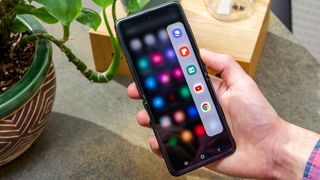
Multitasking on the Galaxy Z Flip is simply a matter of swiping right from the side of the screen to bring up a tray of apps that support the feature. I was able to watch YouTube videos in one panel on the Z Flip screen while browsing through mail on the other.
Some apps work better than others with the Multi-Active Window feature. I wouldn’t advise playing PUBG Mobile while running another app in a different window, though you could in theory. The feature works whether you’re holding your phone in portrait or landscape mode.
Samsung Galaxy Z Flip review: Verdict
It didn’t take long a lot of testing for our Samsung Galaxy Z Flip review to realize that Samsung had built the most polished foldable phone yet — at least until the Galaxy Z Fold 2's subsequent release. Even though the new Fold now sets the standard for foldable devices, the Galaxy Z Flip remains a well-built phone that provides a big, colorful screen still capable of folding into a device that fits neatly into your pocket.
Features like Flex Mode that take advantage of the Z Flip’s screen mean that foldable devices are more than just gimmicks, though Flex Mode would be even more useful if more apps took advantage of the feature.
That doesn’t mean the Galaxy Z Flip is ready to go toe-to-toe with the leading flagships. For starters, those phones may be pricey, but with the exception of the Galaxy S20 Ultra, they’re still cheaper than the Galaxy Z Flip. And while the Z Flip’s cameras certainly produce pictures that match up well with what you’d get from the best camera phones, you’d expect a little something more for a phone that will set you back $1,200 to $1,300, even after Samsung's price cuts. (There's also the possibility of a new Galaxy Z Flip coming out later this year, which might make you wary of springing for an older foldable phone.)
So yes, the Galaxy Flip Z is among the best foldable phones you can buy. That’s not enough to make it an alternative to something like the iPhone 12 Pro Max or Galaxy S21 Plus, but the advances Samsung made with this device over the Galaxy Fold makes us think that foldable phones actually have a future.
Editor Adam Ismail contributed to this review.
Philip Michaels is a Managing Editor at Tom's Guide. He's been covering personal technology since 1999 and was in the building when Steve Jobs showed off the iPhone for the first time. He's been evaluating smartphones since that first iPhone debuted in 2007, and he's been following phone carriers and smartphone plans since 2015. He has strong opinions about Apple, the Oakland Athletics, old movies and proper butchery techniques. Follow him at @PhilipMichaels.
